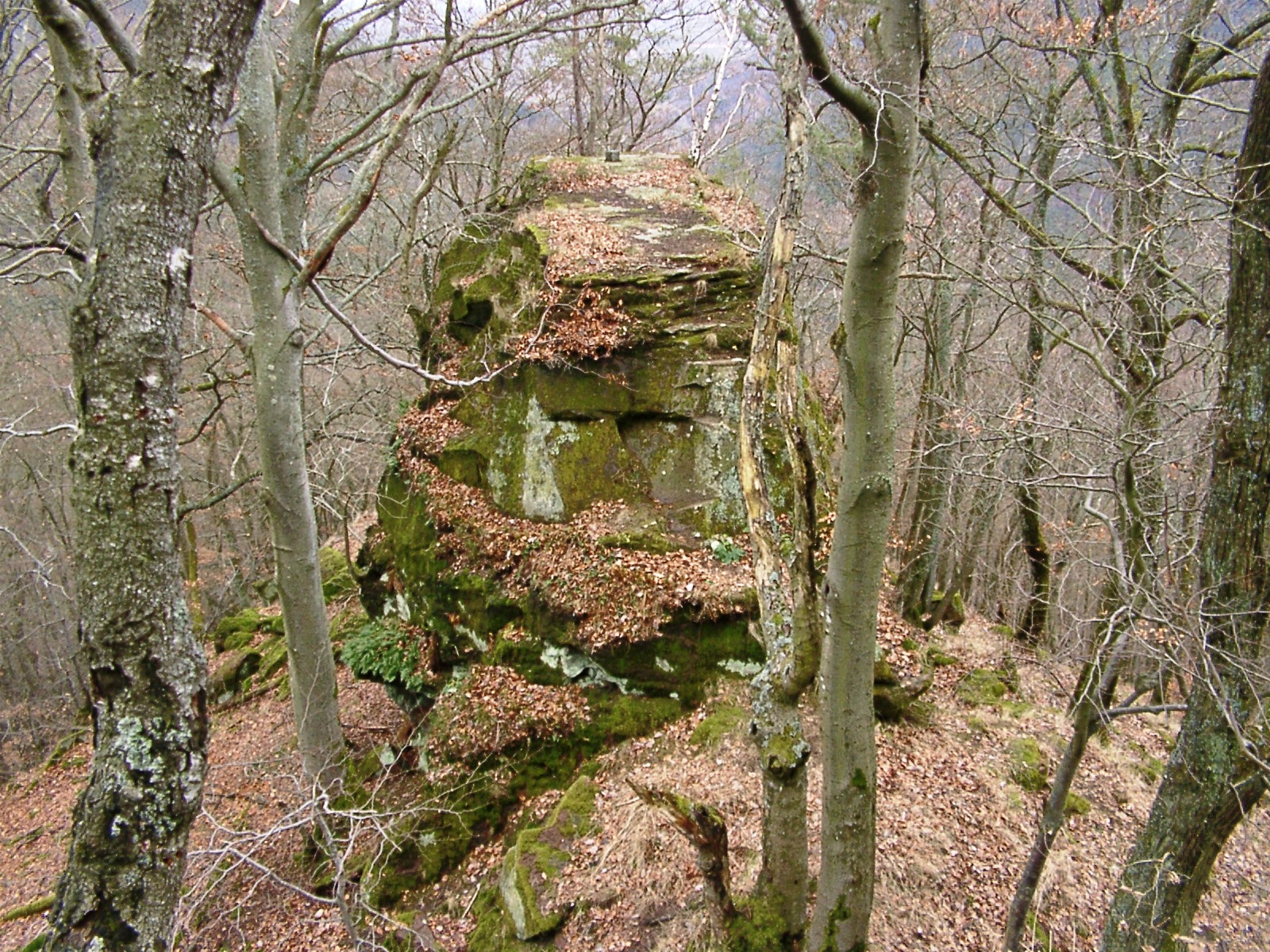Frankenfelsen on:
[Wikipedia]
[Google]
[Amazon]
 The Frankenburg is a natural monument with the
The Frankenburg is a natural monument with the
 The castle stands on a rock whose sides have been vertically cut. Visitors may reach the castle using a rock staircase. The ''
The castle stands on a rock whose sides have been vertically cut. Visitors may reach the castle using a rock staircase. The ''
ruins
Ruins () are the remains of a civilization's architecture. The term refers to formerly intact structures that have fallen into a state of partial or total disrepair over time due to a variety of factors, such as lack of maintenance, deliberate ...
of a rock castle
A rock castle () is a type of medieval castle that directly incorporates natural rock outcrops into its defences to such an extent that the rock formations define the structure of the castle. Topographically, rock castles are classified as hill ...
in the county of Südliche Weinstraße
Südliche Weinstraße (; ; ) is a district (''Kreis'') in the south of Rhineland-Palatinate, Germany. Neighboring districts are (from west clockwise) Südwestpfalz, Bad Dürkheim, the district-free city Neustadt (Weinstraße), Rhein-Pfalz-Kreis ...
in the German state of Rhineland-Palatinate
Rhineland-Palatinate ( , ; ; ; ) is a western state of Germany. It covers and has about 4.05 million residents. It is the ninth largest and sixth most populous of the sixteen states. Mainz is the capital and largest city. Other cities are ...
. It lies above the Modenbach
The Modenbach is a stream, just under {{convert, 30, km long, and a right-hand tributary of the Speyerbach in the German state of Rhineland-Palatinate.
Course
The Modenbach rises in the Palatine Forest east of the Palatine Watershed at a heigh ...
valley on a rocky outcrop of the ''Frankenberg'' called the ''Frankenfelsen'' and was built to guard the road opposite Meistersel Castle
Meistersel Castle is a ruined castle near Ramberg on the outskirts of the Palatinate Forest in Rhineland-Palatinate, Germany. It is located on a 492-metre-high hilltop that towers above the Modenbach valley near the Three Beeches pass ('' Drei B ...
.
Today, all that remains of the Frankenburg are a few wall remnants and manmade traces on the rock. The rocky outcrop on the Frankenberg lies at a height of 545 metres above sea level.
History
The first record of the castle dates to 1327, when James of Ruppertsberg opened thecastle
A castle is a type of fortification, fortified structure built during the Middle Ages predominantly by the nobility or royalty and by Military order (monastic society), military orders. Scholars usually consider a ''castle'' to be the private ...
to Count
Count (feminine: countess) is a historical title of nobility in certain European countries, varying in relative status, generally of middling rank in the hierarchy of nobility. Pine, L. G. ''Titles: How the King Became His Majesty''. New York: ...
Jofried of Leiningen on the occasion of an ''Urfehde'', a sworn agreement not to feud. Before 1353 the Frankenburg was under the rule of the lords of Dahn. In the 15th century it was presumably abandoned and fell into ruins.
Description
bergfried
''Bergfried'' (plural: ''bergfriede''; English: ''belfry''; French: ''tour-beffroi''; Italian: ''torrione''; Castilian: ''torre del homenaje'') is a tall tower that is typically found in castles of the Middle Ages in German-speaking countries an ...
'' probably stood on the top of the rock with the ''palas
A ''palas'' () is a German term for the imposing or prestigious building of a medieval '' Pfalz'' or castle that contained the great hall. Such buildings appeared during the Romanesque period (11th to 13th century) and, according to Thompson ...
'' below it.Friedrich-Wilhelm Krahe: ''Frankenberg''. In: ''Burgen des Deutschen Mittelalters. Grundriss-Lexikon''. Würzburg, 1996. and there appear to have been wooden huts on the castle rock, supported on beams that fitted into the putlock hole
Putlog holes or putlock holes are small holes made in the walls of structures to receive the ends of poles (small round logs) or beams, called putlogs or putlocks, to support a scaffolding. Putlog holes may extend through a wall to provide staging ...
s on the rock. A few small remains of a curtain wall can still be made out. Access to the castle is interrupted by a wide neck ditch
A neck ditch (), sometimes called a throat ditch,
at www.roadstoruins.com. Accessed on 3 Jan 2012. is a dry
Castle data bank of the European Castle Institute
at www.roadstoruins.com. Accessed on 3 Jan 2012. is a dry
rusticated ashlar
image:Palazzo medici riccardi, bugnato 01.JPG, Two different styles of rustication in the Palazzo Medici-Riccardi in Florence; smooth-faced above and rough-faced below
Rustication is a range of masonry techniques used in classical architecture g ...
s are still visible and individual pottery finds suggest that the castle dates roughly to the 13th century.
Literature
* Jürgen Keddigkeit (ed.): ''Pfälzisches Burgenlexikon''. Vol. 2. Institut für Pfälzische Geschichte und Volkskunde, Kaiserslautern, 2002, , pp. 111–115.External links
Castle data bank of the European Castle Institute
References